Northern Exposure | How the ATV Boom is Changing the North Woods
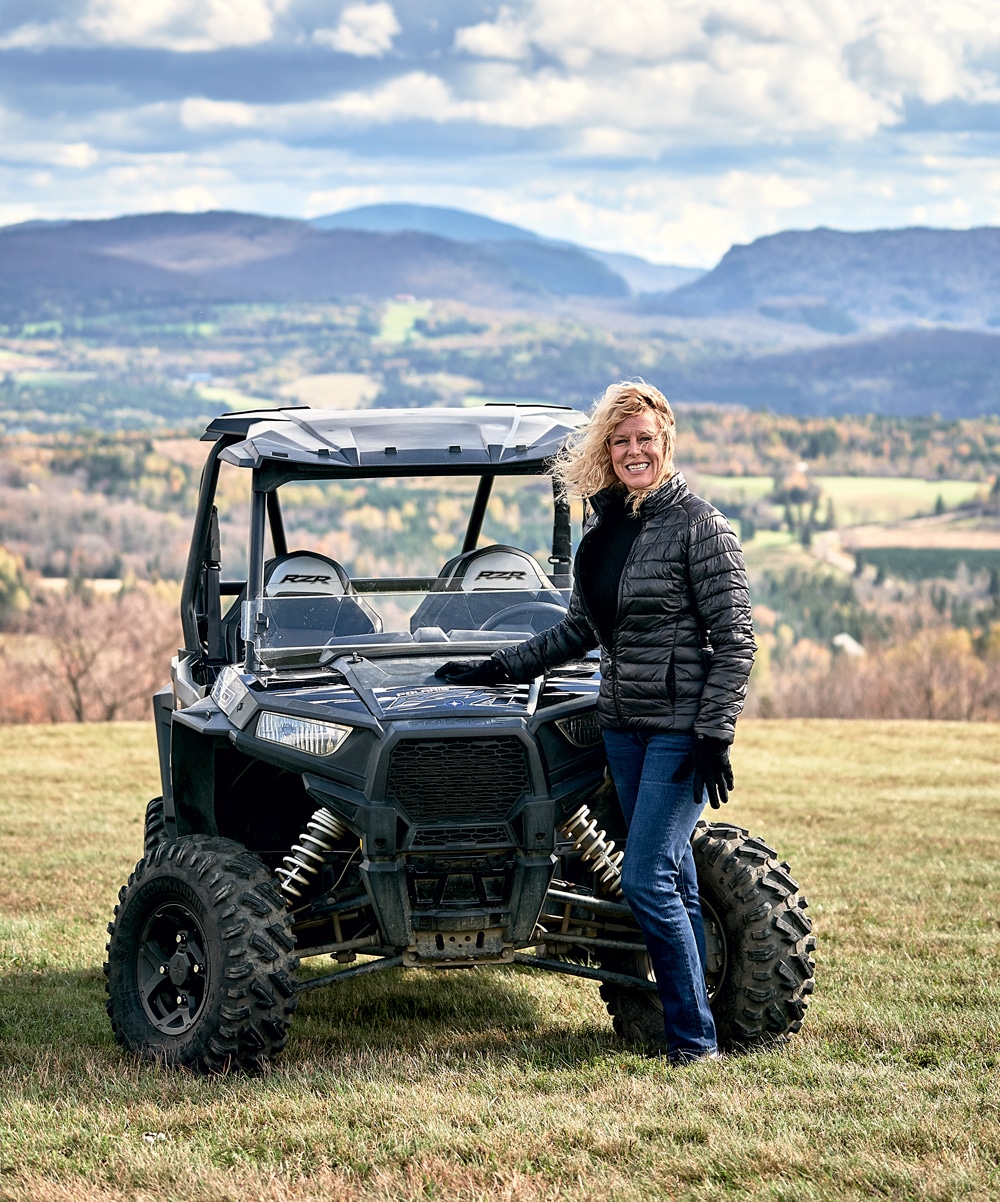
Though she has long loved hiking and biking in the mountains, Corrine Rober recognized the business potential of ATV tourism, and in 2013 she and her husband launched Bear Rock Adventures in Pittsburg.
Photo Credit : Mark FlemingFor “Adventurous Spirit” (season 1, episode 6), Weekends with Yankee headed to Lisbon, New Hampshire, where co-host Richard Wiese hopped on an ATV to see firsthand why this New England pastime is so popular in the northern part of the state, especially during peak foliage season. Learn more about how the ATV boom is changing the North Woods in this 2019 Yankee feature by deputy editor Ian Aldrich.
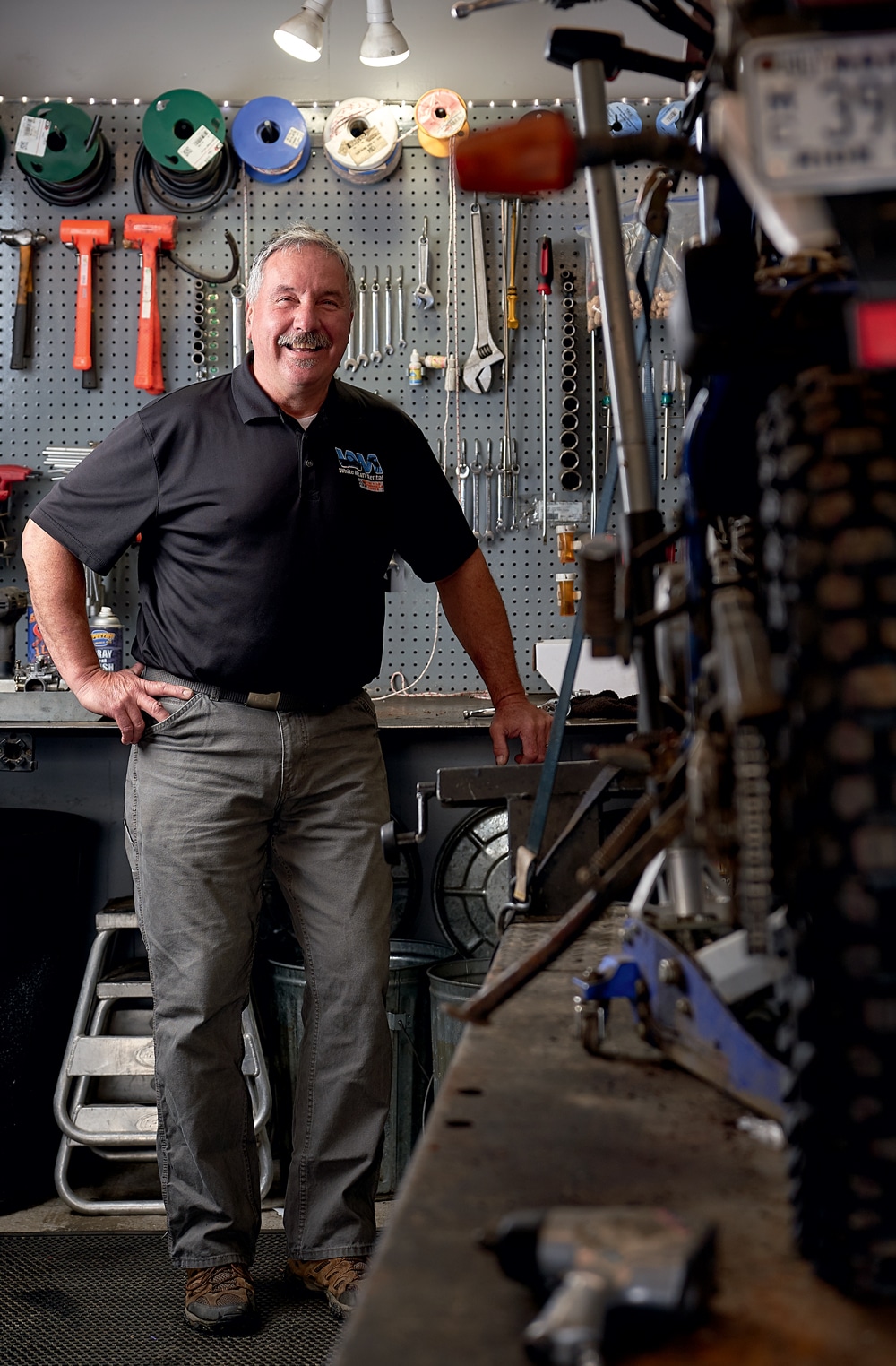
Photo Credit : Mark Fleming
But we both know Bergeron isn’t really asking. Before I can answer, he presses the accelerator and we plunge forward. Over the next 10 minutes we descend and climb, ripping around tight corners, spraying gravel in our wake. I hold on tight. Bergeron, who is 58 and has spent the bulk of those years wrenching on cars and power-sports equipment, navigates the terrain with the confident ease born of experience. Gunning here, laying off there. At different moments he snaps his head back toward me. “You still here?” he asks, letting out a laugh. The first time, I’m sure he’s joking. After the third time, I’m not so sure. “He’s still with us,” he confirms to my colleague and photographer, Mark Fleming, who’s riding shotgun. Is Holt’s a one-way trail? I’m afraid to ask.
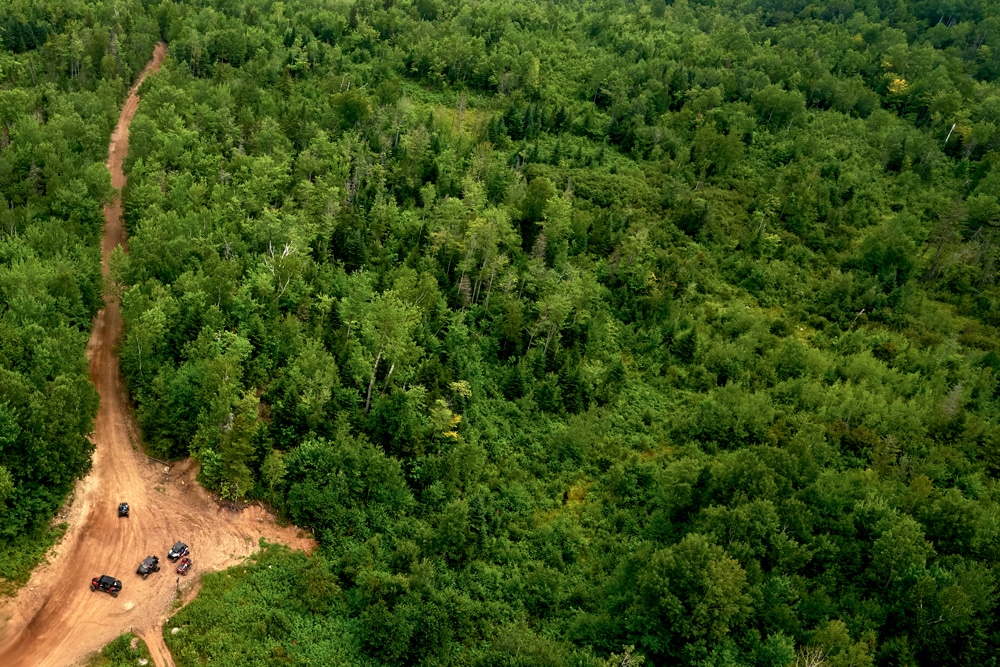
Photo Credit : Mark Fleming
Thankfully, we have the route to ourselves. But that’s not the case with the rest of Jericho Mountain State Park, home to its namesake mountain and, on this early August weekend, the center point of the Jericho ATV Festival, a two-day carnival of mud pit runs, obstacle course rides, professional freestyle shows, and free rein over the park’s 85 miles of trails. In all, nearly 7,000 people will descend on Jericho for the weekend. Many have come from southern New England, ATVs in tow, with money to spend on food, hotel rooms, and even brand-new $25,000 machines.
In a region that has spent the better part of two decades sputtering to formulate a post–paper mill identity, this weekend is seen by many as a sure sign that a new and unexpected tourist economy, one that revolves around ATV riders, has emerged for New Hampshire’s Coos County. New businesses have opened, familiar ones have expanded, and as the dollars have rolled in, the small towns that dot the mountain landscape have increasingly catered to the influx of visitors. They’ve opened their roads to ATV use, allowing greater access to more than 1,000 miles of trails that snake through the region.

Yet as this developing economy has taken hold, it’s deepened old divisions and created new ones over how the most northern part of the state should be transformed. Nobody debates that the region’s deep wilderness is its most sellable asset. But how it’s leveraged is at the center of a battle that’s pitted residents, even family members, against one another. In Gorham, which is the epicenter of some of the White Mountains’ most popular hiking trails, a group of neighbors sued the town and the state last year, charging that the community’s embrace of ATVs had permanently damaged their way of life. Every change has a price. But who pays it, the lawsuit essentially asked, and how much should be extracted from them in order to boost the fortunes of a region?
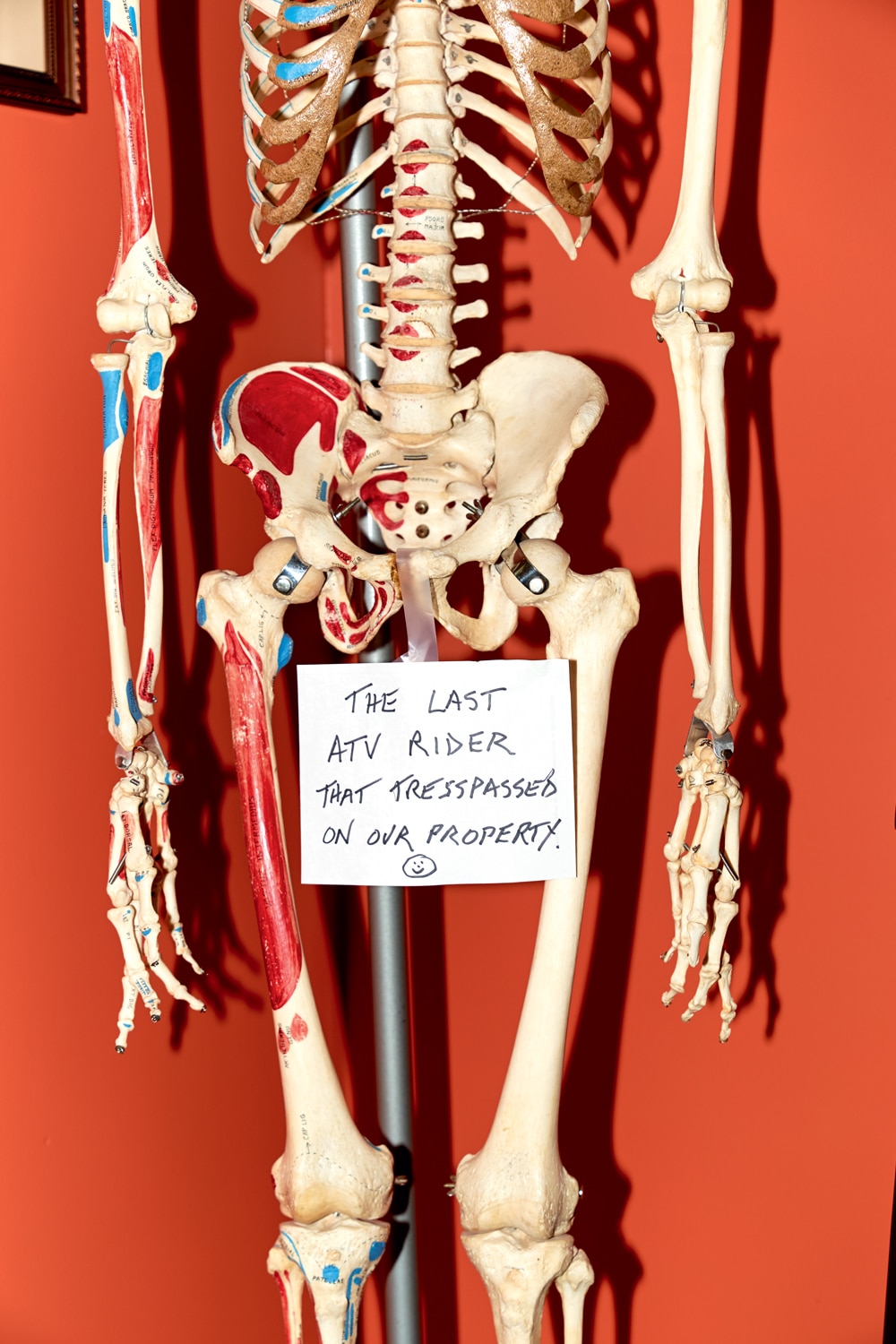
Photo Credit : Mark Fleming
“It’s like the whore on a street,” one longtime Gorham resident told me. “Sure, the money is good. But one day nobody will want her anymore. That’s kind of what I think we’re doing to ourselves. We’re polluting with noise and dust, and we’re not thinking. We’re just taking the money.”
Bergeron, a Berlin native, doesn’t see it that way. As the owner of White Mt. ATV Rental in downtown Gorham and head of the Presidential OHRV (Off-Highway Recreational Vehicle) Club, he promotes off-roading with an outsize enthusiasm that is both infectious and gravitational. He talks with equal passion about how ATVs have opened the outdoors to a new swath of people and about the work his volunteer crew has done to clamp down on the “small percentage of knuckleheads” who feel the need to let loose in the wrong areas.
When we veer off Holt’s Revenge Trail to stop at a popular ridgetop clearing, he roams the peak, shaking hands with customers he recognizes, greeting state officials with a chummy familiarity, and doing general check-ins with other riders on how their machines are performing. He’s in constant sales mode: selling his business, selling the region, selling the power of this new economy. There’s too much at stake otherwise, he says.
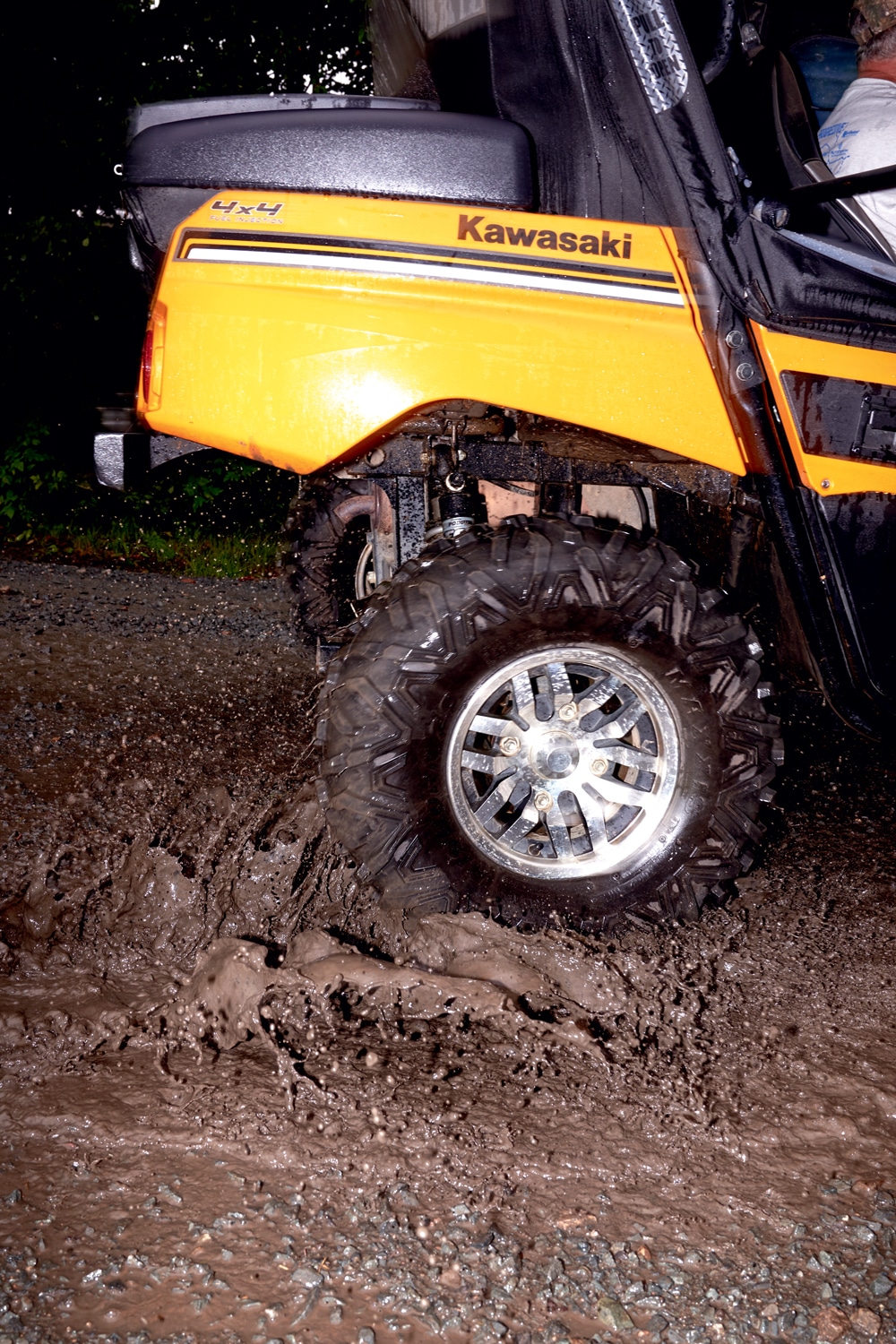
“We have a lot to lose,” Bergeron says. “A lot of my friends had to leave after the mills closed. I was the first one to see it, because I deal in ‘toys.’ Hey, Ray, can you sell my snowmobile? Can you sell my Harley?
“I know what the people who I like to call the naturalists think of me,” he continues, “that I’m one of the ones who brought all these carbon-spewing vehicles into the area.” He laughs. “I’m a big-ass target. Guys like me [are seen] as people who gun it, do wheelies, make noise, and go like a bastard!” Then his voice softens. “But that’s not us. We’re just out here looking at the scenery in a different way.”
* * *
To understand northern New Hampshire’s embrace of the ATV economy, it helps to know the story behind the economy that preceded it. When Berlin was incorporated as a town in 1829, small lumber mills were already running on the Androscoggin. By the mid-1890s, Berlin had become a major paper producer, driven in part by the success of the Berlin Mills Company. Renamed the Brown Company in 1917, it employed between 600 and 800 in the summer, up to 1,200 men in logging camps during the winter, and 450 river drivers in the spring.
The Brown Company was also at the heart of community life. It built a school on its property and hosted dances and opera house plays. The Brown family’s home on Church Street was a point of local pride.
But the Depression and greater postwar competition eroded the firm’s dominance. In 1968 Brown was sold to Gulf and Western. It was sold again in 1980, then once more in 1995. Each sale initiated a round of attrition. In 2001, the mill temporarily closed. It later reopened as a pulp plant but shut its doors for good in 2006. Today, Berlin’s population is about 10,000—half what it was a century ago.
Just a few miles south, Gorham’s fortunes have fared only slightly better. Gorham Paper and Tissue is still in operation, but it employs just 110 people, and its viability is always in question. In 2018, the mill fell behind on its tax payments, and for a time its executives did not return phone calls from town officials.
For the Gorham-Berlin region, the mills’ struggles couldn’t have come at a worse time. The closures arrived just as the global economy took a deep dive, taking other employers down with it and further weakening a region that was already teetering on the edge. Starting in 2008, for example, Gorham went four years without a single new building permit application.
“People had no sense of a future,” Berlin mayor Paul Grenier told me. “They were encouraging their kids to leave the area. You’re never going to get a job here. Get out. And the kids were leaving.”
As the region’s mill economy was unraveling, one of Grenier’s predecessors, Robert Danderson, began eyeing what was happening in West Virginia. In the southern part of the state, a tract of former coal mining land had been converted into a 600-mile off-road riding network known as the Hatfield-McCoy Trails. In its first five years of operation, an estimated $25 million had been injected into the local economy.
Danderson saw a similar opportunity in Berlin, in an underused 230-acre city park just a few miles from downtown. With the state looking to meet the demands of a growing interest in ATV terrain, he approached officials at the Department of Resources and Natural Development about turning the area into an off-road destination. In 2005, the land was combined with an adjoining 7,200-acre swath to create Jericho Mountain State Park.
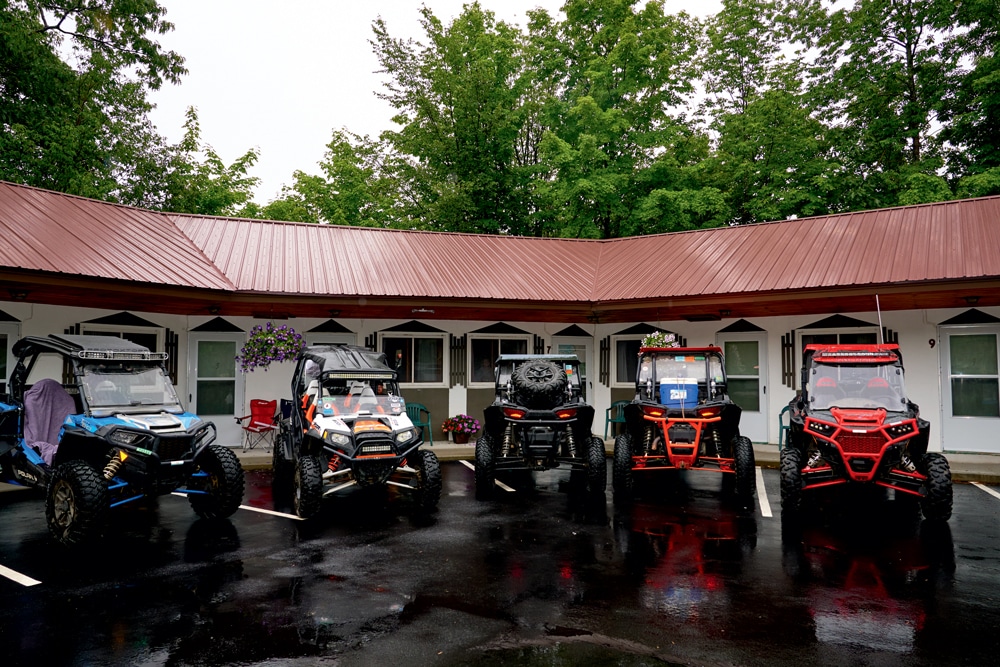
Photo Credit : Mark Fleming
“I had read that snowmobiles added something like $1 billion to New Hampshire’s economy, and that amazed me,” Danderson, a retired public utility employee, told me by phone from his home in Florida. “Gas, hotels, buying machines [and] accessories—I felt ATVs would surpass that eventually, because you’ve got the longer season and you’re not as weather-dependent.”
Not long after the state park opened, a movement began to widen the county’s ATV reach. The aim was both simple and complicated: to bring together a patchwork of logging roads, state land, and snowmobile trails to create a vast riding network. The county’s 11 main off-road volunteer clubs and three chambers of commerce played nice, finding compromise and shelving local agendas for what they saw as the greater good. In June of 2013, Ride the Wilds, a 1,000-mile collection of trails that extends from Gorham to Pittsburg, on the Canadian border, was officially dedicated.
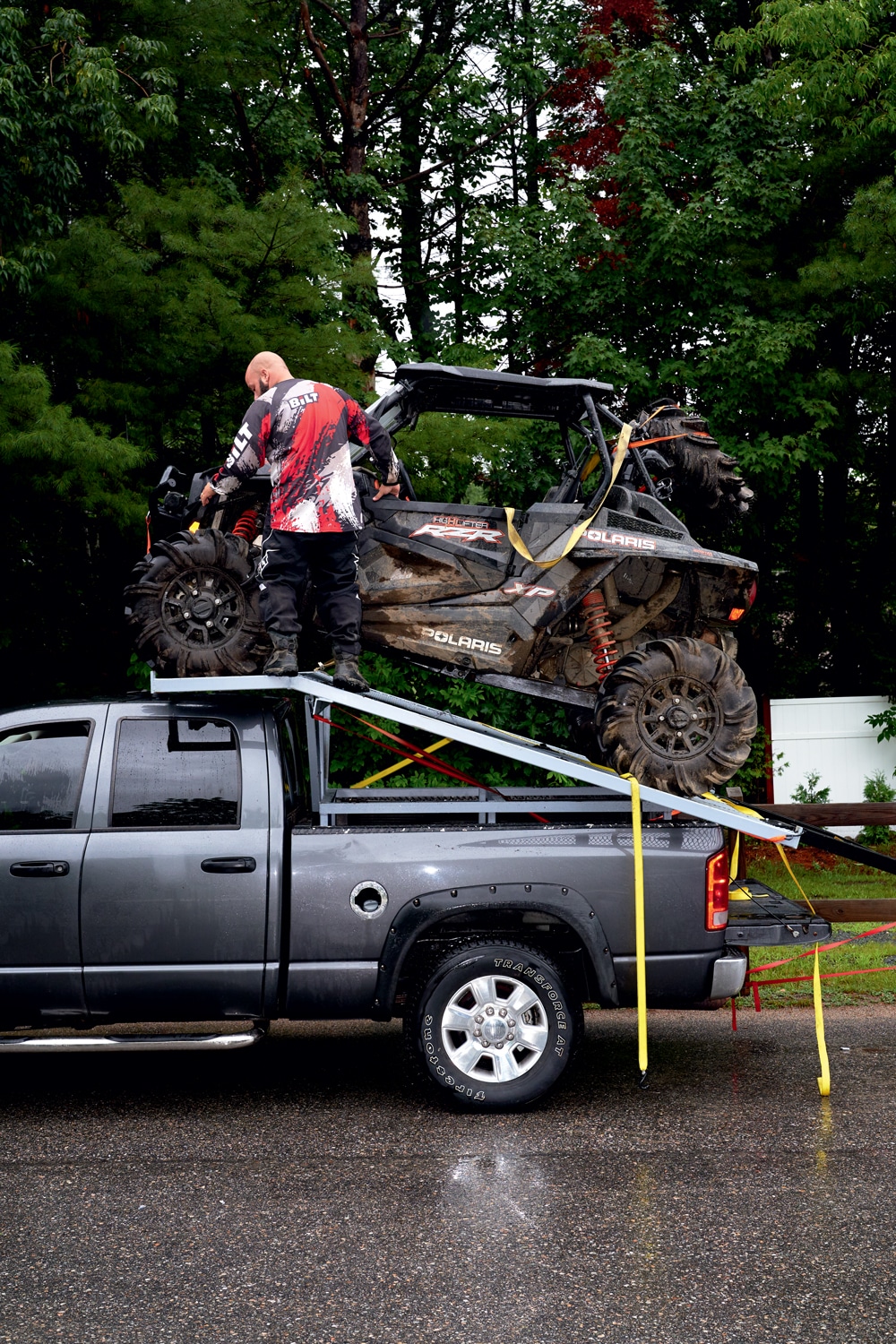
In the years since, the region’s off-road identity has been defined by growth and controversy. As the county’s ATV economy has taken shape, its presence has become amplified in everyday life. In communities like Gorham, Berlin, and Stark, drivers and riders share local roads between May and November. That’s no small matter. The convenience of ditching a truck or trailer and riding directly to a trailhead or a restaurant, or back to a motel after a day in the woods, is one of the prime selling points for visiting the region, tourists and town officials told me.
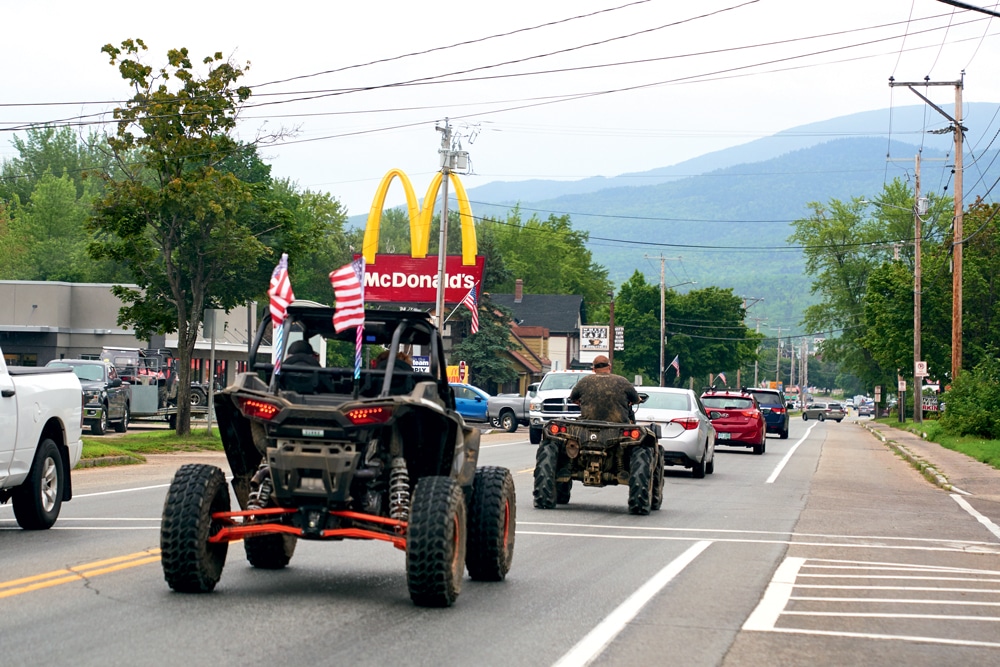
But in embracing this kind of tourism, communities have contended with other issues born from the conveniences they’ve fostered. Noise and traffic never really cease for those who live near a trailhead, and in a state that permits drivers as young as 12 to operate an off-road recreational vehicle, safety is another concern.
“I think we all understand that ATVs can play a part in the economy up here, but we seem to be losing sight of any kind of balance,” said Howie Wemyss, general manager of the Mount Washington Auto Road in Gorham. “It’s just ATVs all the time. Are we driving away the people who have always come here? What are the effects?We don’t know. If you listen to the ATV folks, it’s all great—the more the better. If you listen to the others … maybe that’s not the case.”
* * *
What brings people to New Hampshire’s Coos County today are many of the same things that have always brought people to the region. Encompassing both the White Mountain National Forest and the expanse of the Great North Woods, it offers visitors access to vast tracts of wilderness—a rarity in the increasingly land-fractured Northeast. And even decades after highways and technology have granted its residents greater connectivity to the broader world, a proud sense of isolation pervades the place, where self-reliance and a sense of local community are as prized as any currency.
Those were the kinds of things that called to Lois and Harry “Court” Stearns. As their retirement came into focus, the couple, who’d spent much of their married life in the region, knew they wanted to settle close to woods and waters where Court could pursue his hunting and fishing passions. In 2005, the Stearnses moved from South Dakota, where Court, an orthopedic surgeon, had finished a six-year stint at a hospital in Rapid City, and into a newly built five-bedroom home just outside downtown Gorham. It was bigger than what they wanted, but it packed an aesthetic and a setting that couldn’t be beat. There was a large fieldstone fireplace, big windows that opened up to acres of woods, and a former railroad bed that Lois walked daily with her dogs.
“It was in town but felt like a camp,” Lois told me as we sat around her dining room table. “We just felt like, What a place!”
During my visit we were joined by two of Lois’s friends: Sandy Lemire, who lives right down the road on Route 2, and Mark Malia, another neighbor. It was early August when we met, late morning, and the Jericho ATV Festival had kicked off only a few hours before. Its presence was impossible to ignore. Around Lois’s house buzzed the sound of off-road machines. Riders rumbled down the old railbed, a mere hundred yards from the home, then banked a left and blasted up a wide gravel path running behind a stand of trees that only partly shielded the house from the trail. When describing her affinity for her home and life in Gorham, Lois talked strictly in the past tense.
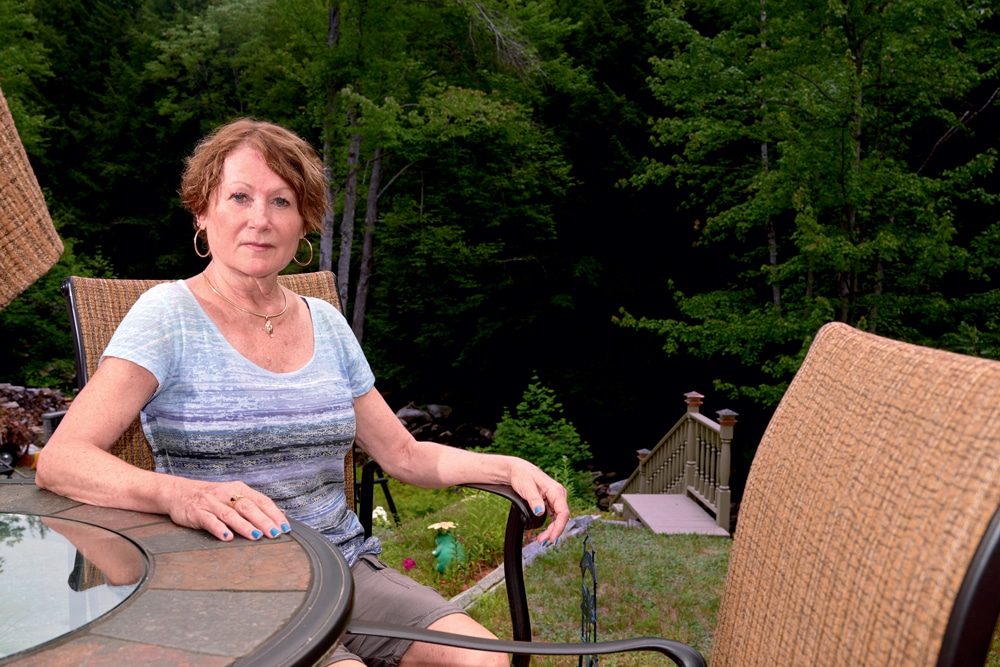
Photo Credit : Mark Fleming
The change began in 2011, when Gorham’s board of selectmen opened up existing snowmobile trails to ATVs, which would affect the region in a way that few foresaw. But the Stearnses quickly realized what it meant. Maybe more than any other place in Coos County, their home was in the cross hairs of the region’s ATV scene. Off-road trails wrap around the property’s borders, while the town’s main off-road parking lot is next to the driveway. It wasn’t long before the lot began regularly filling up with the trailers and trucks of out-of-town riders who wanted to make the 10-mile journey to Jericho on their machines.
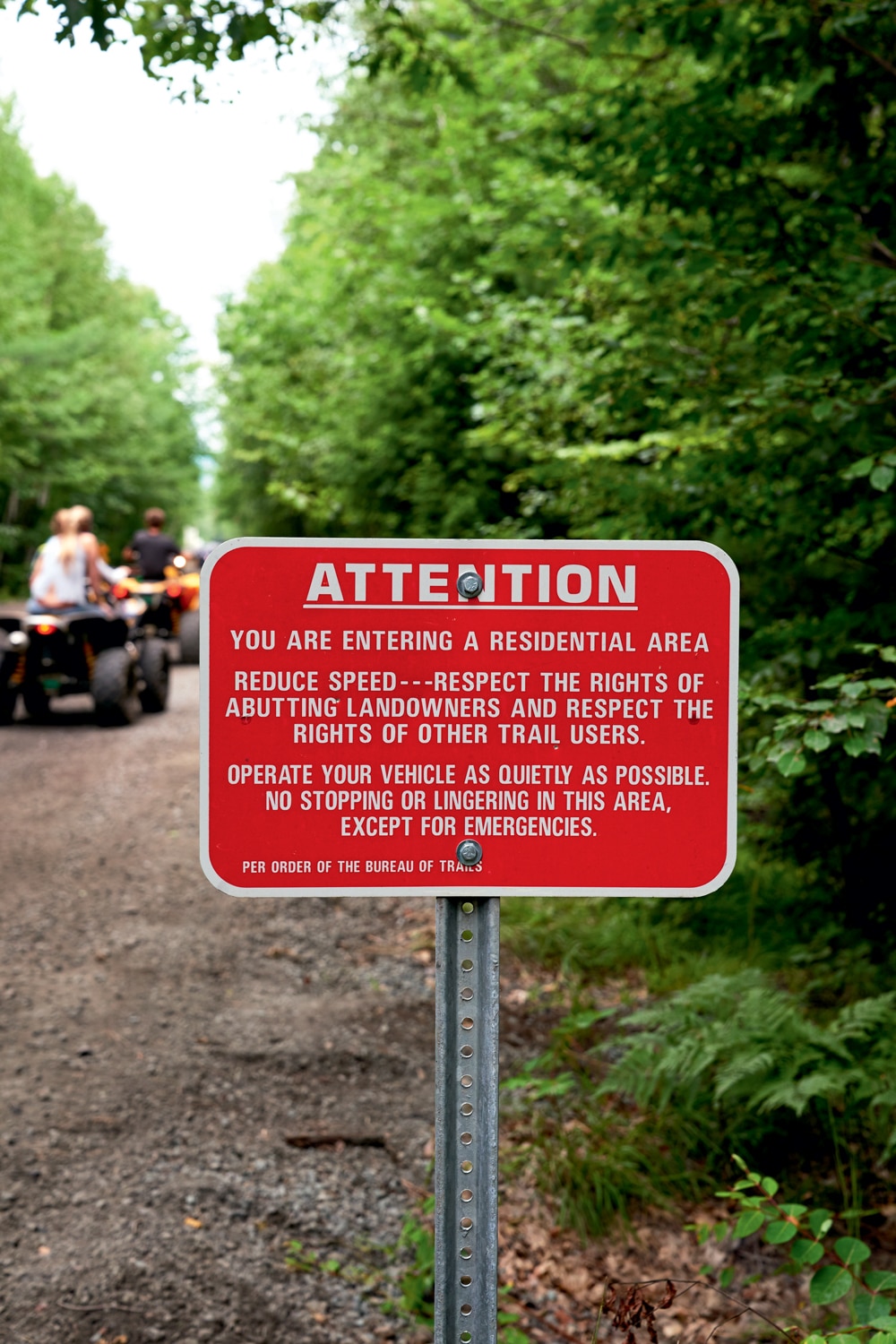
For the Stearnses, who owned ATVs themselves, and for others who lived on or by the trails, it completely changed the tenor of their homes. They rallied to speak to town officials, to plead for them to move the trailhead or reconfigure the trail. There were lengthy discussions between the opposing parties, and a committee even met for a time to hash out the differences. But with the ATV scene only continuing to grow, the acrimony and mistrust never subsided. Then, in March 2018, the bad feelings escalated when 13 Gorham residents filed their lawsuit against the town and the state. Both Lemire and Malia are a part of the case, but the Stearnses are the lead plaintiffs.
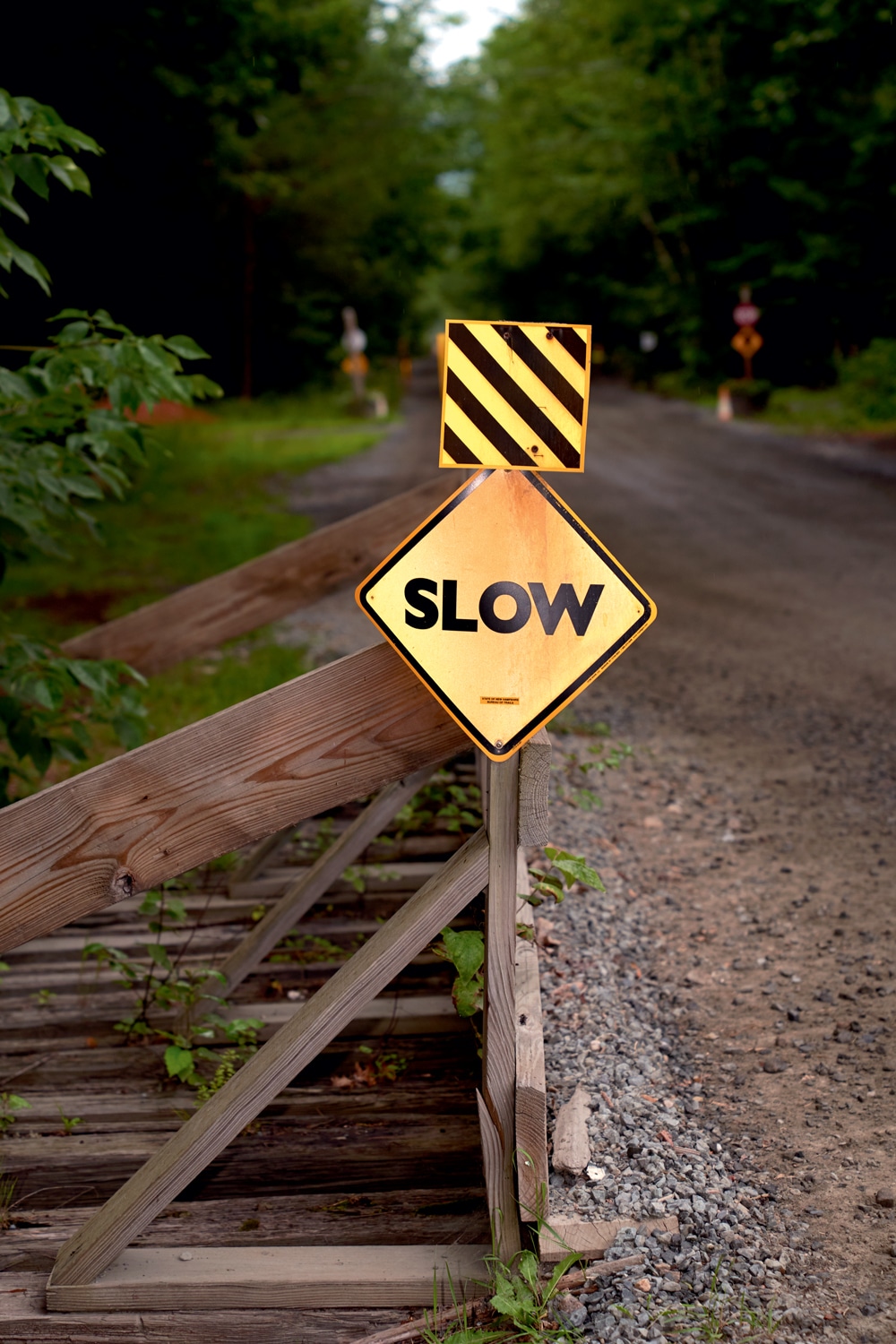
Even more than his wife, Court became consumed by the situation. It was all he talked about, ranting to anyone who would listen about how his quiet retirement “dream” had been ruined. Lois pleaded for them to move, but her husband dug in. Sometimes he’d sit on his backyard deck, taking long drags off a cigarette as he watched the machines buzz by his house. At one point, Lois recalls, Court camped out at the end of the driveway with his rifle to let riders know of his presence. In another instance, he placed a fake skeleton in the corner of a room with a sign that read, “The last ATV rider that trespassed on our property.”
As his home environment seemingly worsened, his mood grew darker. He and Lois fought constantly. “The thing was eating him up,” she said. On June 1, Court Stearns took his own life.
* * *
There’s a common language that both sides of this issue use to describe their situation. Neither party feels as though they can speak up or talk too loudly about their position for fear it will incite the other camp. I heard this from Ray Bergeron, and I also heard it from Lois Stearns, Lemire, and Malia, who all described moments when riders purposely stopped in front of their homes to rev their machines. Through the buzz of those ATVs, they sometimes heard these visitors yell obscenities, they claimed.
Over the course of much of last summer, a shell-shocked Lois barely left her house. She struggled to find the space to mourn her husband while feeling imprisoned in a home that no longer felt like hers. After Court’s death, she installed a pair of dead bolts on her front door, which she keeps locked at all times; her windows also stay closed, even on warm summer days. And yet the sound of the machines remains a constant soundtrack in her life. Several times as we talked, she stopped mid-sentence. “Do you hear that?” she asked. Her hands shook with anxiety. Lois, who grew up in Berlin, talked constantly of just wanting to sell the house and leave.
“I’m out of here,” she said. “They tell me not to do anything drastic for a year, but I can’t stay. I have to get the hell out. I’m petrified. I’m a wreck.”
About an hour into our conversation, we headed outside. She showed me the trees and shrubs she and Court had planted, the outdoor oven they had built. She pointed out the spot along the edge of the woods where frequently they’d see a mama bear and her cubs. Then we hit the rail trail by her house and walked a section of the corridor behind her property that leads to Jericho. A steady stream of ATVers rolled past us. They were all courteous, and as the drivers neared they slowed their machines much lower than the posted 15 mph limit. Many waved as they motored by.
We kept walking up the main trail until we were directly behind the Stearnses’ house. From this vantage point, it was easy to see what had first drawn the couple to the property. There was the babbling brook, and just beyond that the landscaped backyard, and then the house and those big windows. For a brief moment, the sound of ATV machines was just a faint background noise. Lois had the woods and her house to herself.
“It looks like a different place,” she said. “It looks so different from here.”
* * *
It was pushing noon when I returned to Jericho Mountain State Park for the second day of the ATV festival. After a morning of heavy rains, patches of blue sky had begun to show. The crowds were starting to pick up, and a long line extended not far from the entrance at the Can-Am tent, where visitors were waiting to test-drive new models. The growth of New Hampshire’s off-road economy has been aided by the development of a higher-end class of machines. Those simple, single-seater utility types that farmers latched on to in the 1980s are about as coveted these days as dial-up service. Today it’s all about the side-by-side, with room for up to four; burly suspension systems; high-powered motors; and semi-enclosed cabins. At a festival like Jericho’s, where bank representatives, dealers, and rows of new machines are splayed across the grounds, the temptation to upgrade can be too hard to pass up.

At the front of the Can-Am line, a young man sporting a big smile approached his wife. “That was the bank,” he said. He then turned to the two guys behind the vendor table. “I’m gonna have to set this test drive aside. I just got a new machine.”
“What’d you pick up?” one of the reps asked.
“A Polaris Sportsman Touring XP 1000,” the guy replied, beaming. The two men gave approving nods. “It’s another one for the fleet.”
“Fleet?” I interrupted. “How many do you have?”
“It’s our sixth,” he said. He shrugged and looked at his wife, who was trying to wrangle their two young kids, then back at me. “I didn’t say we could afford it.”
On the other side of the festival grounds, not far from the credit union tent where the man I met was finalizing a new loan, I found Paula Kinney, executive coordinator of the Androscoggin Valley Chamber of Commerce. She was bogged down with a last-minute request by a vendor to use the mud pit for an archery event.
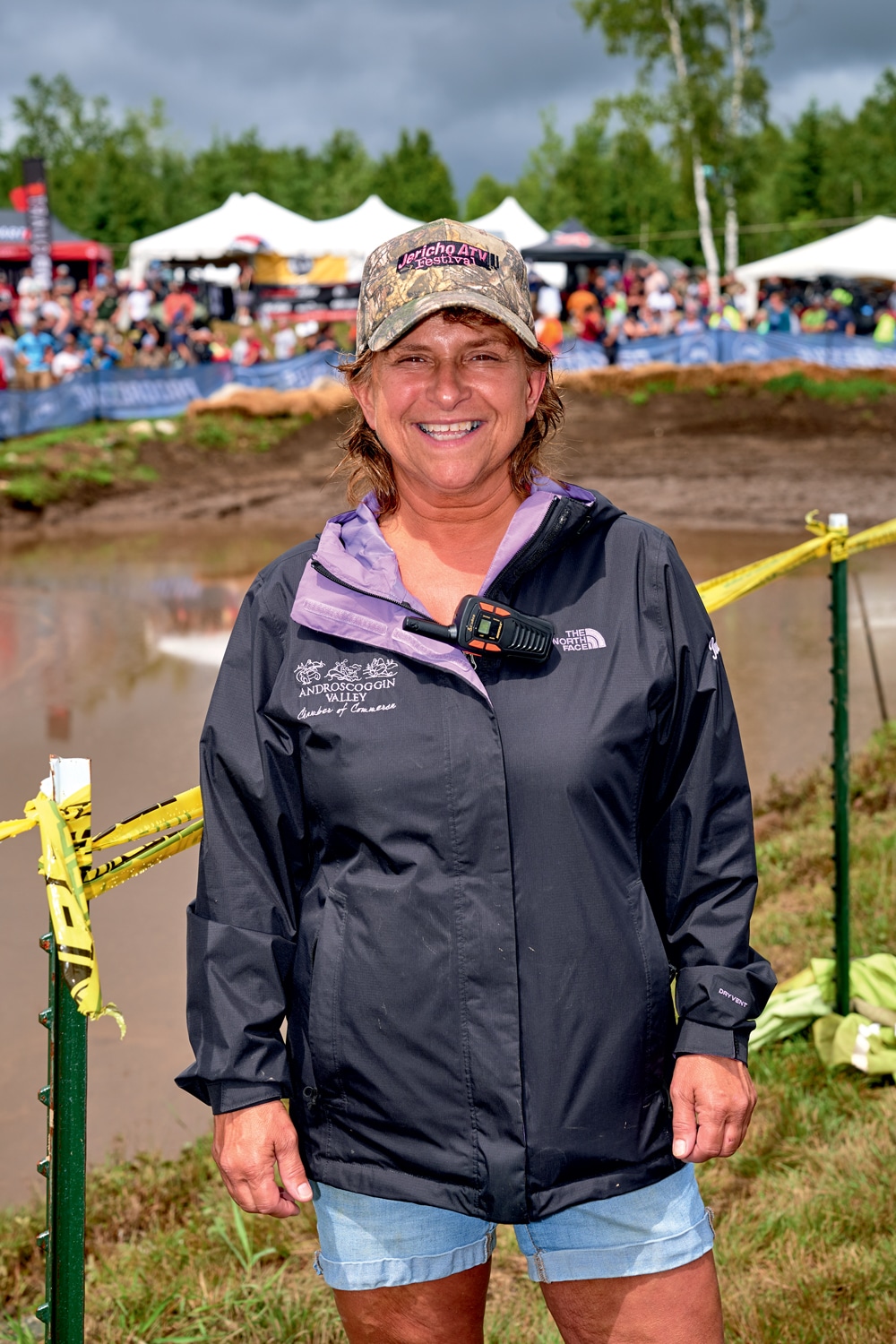
Photo Credit : Mark Fleming
“We can’t do it,” Kinney told a colleague. “You remember we had to stop those foot races in the mud because of the insurance? We’ve already got those machines going through the mud, and people lose stuff, like vehicle parts. They’ll break their necks. I like crazy stuff as much as anyone, but there’s no way.”
Based in Berlin, the chamber is the main organizer of this two-day festival, which essentially makes it Kinney’s baby. Dressed in jean shorts, a black raincoat, a camouflage ball cap, and black rain boots decorated with a scattering of smiling emoji faces, Kinney had been at Jericho since 6 this morning. Already she had contended with a rainstorm that took down the chamber’s tent and had rallied volunteers who were hoping they didn’t have to work because of the weather.
As the day wore on, her spirits were buoyed by a turnout that was putting the event, now in its ninth year, well on pace to break attendance records. Anyone who had a few seconds of her time heard about it. “We set the record last year and I was on cloud nine,” she told me in a voice hoarse from the nearly constant cheerleading she did as she roamed the festival grounds. “If we hadn’t had the rain it would have been even better, but I’ll take it.”
Her enthusiasm was more than just the result of a job well done. There was a sense of hometown pride, too. Kinney grew up in Berlin and had a front-row seat to the town’s changing economics. Her childhood home was next to the paper mill, and out of high school she landed a job with Gamm, a women’s sportswear stitching plant, where she rose to the position of office manager. Three months short of her 20-year anniversary, however, she was hit with the news that the plant was shutting down immediately. Kinney and the 175 women who worked on the floor were instantly unemployed.
A decade ago, a desperate Kinney started volunteering with the local chamber. Symbolic of the greater challenges the community was facing, the organization was struggling to stay afloat. Kinney held bake sales and garage sales, whatever it took to raise the group’s profile and stabilize its books. Eventually she strung together enough of a budget to convince the organization’s board to hire her as a paid employee.
Kinney, who saw early on the economic potential of ATV tourism, is arguably the region’s biggest off-road booster. She will direct people to the chamber’s motto—“Your Adventure Starts Here”—as evidence that her organization supports all kinds of recreation: rafting, hiking, cycling. But without a doubt the chamber is all in on off-roading. The annual festival at Jericho is only one of several big events that the chamber puts together for the riding season, and its embrace of ATVs has put it at odds with some of the other businesses it represents.
Late last summer, Howie Wemyss of the Mount Washington Auto Road withdrew his company’s membership in the chamber after that group signed on as an intervenor to support Gorham and the state in the lawsuit that the Stearnses and others had filed. Wemyss is hardly a staunch opponent of this new economy. Each June his company hosts an ATV day that turns the auto road over to off-road machines exclusively. He offers 1,200 tickets in January for the event, and they sell out in just a couple of days. But the chamber’s decision to pick a side in the lawsuit angered him.
“Clearly the surge in OHRV traffic has provided an economic boost to many businesses in Gorham,” Wemyss wrote the chamber last July. “But it has also decreased the business of some who remain silent for fear of retribution. The OHRV fans do a wonderful job of cheerleading their cause, but where is the balance? Where are the studies to show the real effects that increasing OHRV traffic has on the entire community?”
Kinney isn’t surprised by this level of blowback. She understands that change is hard. She gets that these machines represent a new kind of noise. She even goes so far as to say she’s thankful she doesn’t live near a trailhead, because the sound even gets to her. In fact, after the festival wraps up she often takes a day to find a quiet spot on the Androscoggin in her kayak to decompress. But there’s a bigger picture she has to keep in mind.
“It’s not that I just love ATVs,” she told me, “but I do love what they’re doing for us. When those people are here, they’re coming and spending money. What would we have if they weren’t spending money? That’s the question. I don’t see another group coming here and spending the kind of money ATVers do.”
* * *
An economy of any kind leaves its mark. In the grand old days of the Brown Company, Berlin may have been awash in economic stability, but the business of making paper polluted the water and saturated the air with the persistent odor of sulfur. Even lighter forms of activity have an impact. In recent years the Appalachian Mountain Club has grappled with a record number of hikers who traverse trails that were never made for 21st-century crowds. So in some ways, the issues around ATVs are part of a continuum that began when the earliest European settlers first tried to make a buck from what the region had to offer.
“Tourism is not an industry without impact,” Gorham’s select board chair, Mike Waddell, told me. “There’s noise, a bunch of strangers around all the time; it’s not paradise. Just like we had a trade-off when we had the mills. At least now you can breathe the air, and the Androscoggin River is clear. But people for many decades traded what they breathed, what was on their vehicles when they got up, and a river that flowed with different colors—that’s all within my memory. It’s not without problems, but right now tourism is the only game we got.”
But figuring out the exact economic impact of ATVs isn’t so cut-and-dried. There has been no deep economic analysis of the breadth of the off-road economy in northern New Hampshire. The most accurate metrics come in the form of taxes. And here, there is some good news. Over the past decade, ATV registrations have jumped 80 percent (even out-of state machines need a state sticker). More people are sleeping and eating in Coos County, too. Overall, meals and rooms tax revenue is up 23 percent since 2011.
A more anecdotal portrait of the economy can be found along the three-mile stretch of Jericho Road from downtown Berlin to the state park, where new businesses such as Jericho Deli & Convenience and the off-road dealer Jericho Outdoors have emerged in the past several years. In Gorham, the Royalty Inn has seen a record number of visitors these past few years—so much so that general manager Conrad Klefos recently explored an ambitious plan to turn a shuttered restaurant into an ATV clubhouse, with a lounge and a garage where riders can store their machines.
But for those businesses that don’t cater to the ATV crowd, the picture has been more mixed. At the end of August I returned to Gorham and met with Liz Jackson, who with her husband, Steve, owns and runs the downtown restaurants Libby’s Bistro and Saalt Pub.
Liz is about as Gorham as one can get. She’s a fourth-generation resident who hails from a line of retail and restaurant entrepreneurs. After growing up working in her grandmother’s eatery, she embarked on a food career of her own, studying cooking at the Cambridge School of Culinary Arts and then working as an assistant to Julia Child on her TV series.
After years of exploring and eating around the world, Liz wanted to bring a little more culinary gravitas to her hometown. In 1997, when she was seven months pregnant with her third child, she and Steve opened Libby’s, a French-inspired restaurant that could slide seamlessly into a Brooklyn neighborhood, in a converted bank building. Today it shares space with Saalt, and the two restaurants have successfully carved out a niche just down the road from a McDonald’s and a Dunkin’.
I met Liz on a Sunday night in one of the pub’s dining rooms. The dinner shift was coming to a close, and Liz, who’d cooked most of the day, finally had a chance to sit down to a meal. It had taken some persuasion to get her to talk with me. In earlier years, as debates swirled about how the community should embrace the ATV scene, she’d been especially vocal about her concerns. Liz was all for job creation, but she worried about what it might be pushing out. Was the possible risk to Gorham’s reputation as an AMC hiker–friendly town worth it?
The backlash to her position became severe, she said. Chamber volunteers stopped coming to her restaurant, while other ATV supporters confronted her at meetings, she told me, or fictionalized dining experiences to leave negative Yelp reviews. Two years ago, she withdrew from the chamber.
“I realized there are people out there who would argue for a nuclear landfill if it was going to generate money and they could say it would provide a good job,” she said. “What we’re asking for is just some thoughtfulness about the growth, for the town government to say there are two sides to this and for us to work together. But the town has pitted us against our concerns.”
Like Wemyss, and like the plaintiffs in the lawsuit, she feels there is a place for an ATV economy. What she objects to is its prominence and its placement over other sectors. “If they wanted to have a whole week, like [Laconia’s] bike week, go for it,” she said. “But instead it’s so spread out, it’s just noise, noise, noise all the time. On festival weekends I’m down as much as 60 percent.”
As we talked, the restaurant slowly started to close for the evening. It had been a strong Sunday night, with a good 150 people dining in the two restaurants. Liz has an easy and frequent smile, and as jazz music played in the background she beamed a heartfelt thanks to exiting diners who streamed past our table, many of whom she knew personally. It was a reminder that her main business isn’t food—it’s comfort.
“I like taking care of people, and I think that’s why this neighborhood thing bothers me,” she said. “I can’t imagine not trying to make people feel good and happy. Or running a business that is hurting someone else. My whole business is built around making people feel good about being here. It’s what we do. If you are unhappy, then we have failed.”
A little later in the conversation, she gave me a resigned smile. “At the end of the day, if that’s what they care about, if they value the dollar more than they value their neighbor, maybe this isn’t a community I belong in.”
* * *
Two months after Ray Bergeron introduced me to Jericho’s Holt’s Revenge, I found myself behind the wheel of a side-by-side Polaris machine 65 miles north of Berlin, in the small town of Pittsburg. It was a striking day: cloudless sky, warm, with only a scattering of maples and birches serving notice of the foliage season that was about to hit.
In a region that’s already notably rural, Pittsburg ups the deep-woods feel. Sharing a border with Canada and composing the entire northern top of New Hampshire, its 291 square miles make it the largest municipally incorporated town in New England. Yet it claims just 800 residents. One of its most well known is Corrine Rober, a principal figure behind the success of the Ride the Wilds trail network and the owner of Bear Rock Adventures, an off-road machine rental agency she operates out of her hometown. On this early fall day, she was my copilot and navigator.
In an industry known for its dude-ness, Rober doesn’t fit in with common perception. She’s tall and blond, with a low-key charm that proved valuable during her decade and a half of owning and running a busy family restaurant in Glen. Rober’s path to the ATV business wasn’t the product of following any kind of motorhead passion. She grew up in the mountains, and her preferred method of escaping into the wilderness has always been by foot or on bike. But the businesswoman in her saw off-roading as an opportunity to make a new kind of living after she and her husband, Steve Baillargeon, a logger and Colebrook native, turned a second home up north into their first. Bear Rock opened in May 2013. A month later, Ride the Wilds was dedicated.

of ATV tourism,
and in 2013 she and her husband launched Bear
Rock Adventures
in Pittsburg.
Photo Credit : Mark Fleming
Pittsburg has not been immune to the controversies that have cropped up in other communities. But as a result of the town’s limited population density, it’s also avoided the kind of heated acrimony that persists in Gorham. Still, at the time of my visit, parties on both sides of the issue were keeping a careful eye on the Gorham lawsuit. (A few weeks after my visit, Judge Lawrence MacLeod of the Grafton Superior Court allowed much of the case to move forward, including the plaintiffs’ nuisance and damage claims. But the plaintiffs were denied a preliminary injunction to prevent the town and the state from operating the trailhead by Lois Stearns’s home. This story went to press before a new ruling had been handed down.)
From the shop’s headquarters, Rober directed me down a quiet paved road that skirted Back Lake, and then along a gravel lane that emptied out at the Perry Stream Land and Timber Co., an 8,000-acre parcel of private property that’s coursed with 120 miles of public ATV trails. After motoring through a small clearing, we reached a fork. “Head that way,” Rober said, pointing to a steep uphill trail of ruts and decent-size rocks that poked out of the ground. I slowed the machine down for a second.
I turned to her. “Are you sure?”
“You’ll be fine,” she said.
I was skeptical. But I hit the accelerator and started to climb. It was a jerky journey. I punched and laid off the pedal. I nervously navigated around the rocks and ruts. I stopped, then skidded to a start. As I rolled over one particularly thorny area I was convinced I was going to rip out the machine’s underside. At an especially steep section, I envisioned us just toppling backward. I gripped the wheel tighter. I started to sweat. I thought about pulling over and letting Rober finish the trek. There was no laughing. I was no Ray Bergeron.
But it got better. I finished the climb and then embarked on a series of trails that wound around and down the property. “That was perfect,” Rober said, after I navigated a section of challenging downhill terrain.
No, it really wasn’t, but I did start to get the hang of it. My foot stayed steady on the accelerator. I got a feel for how to navigate the ruts. The rocky stretches weren’t as intimidating. I no longer wanted to hand the wheel over to Rober.
Something else also clicked. I got the appeal. Far removed from the rip-roaring scene at the Jericho ATV Festival, we had the woods to ourselves. It was fun, even thrilling at times. We moved deliberately, stopping here and there to take in a view or talk about a part of the land we were on. If I couldn’t or didn’t hike or mountain bike, here was my ticket into the wilderness, a sight that for generations has brought people together.
I remembered Ray Bergeron’s words: “We’re just out here looking at the scenery in a different way.” And yet I also knew it was this same scenery that had brought Lois and Court Stearns back to Coos County. And I wondered if those on either side of the ATV battle would ever be able to see the beauty the same way again.


